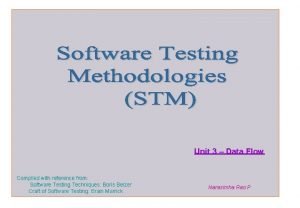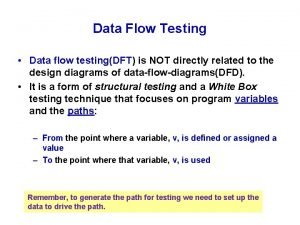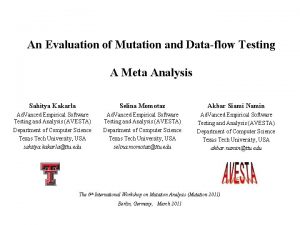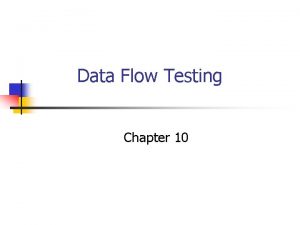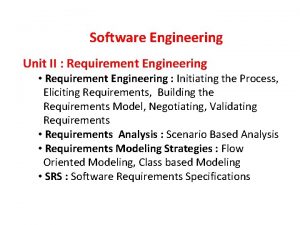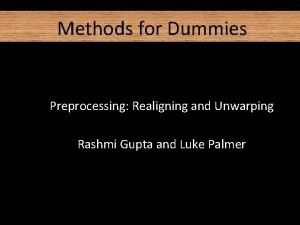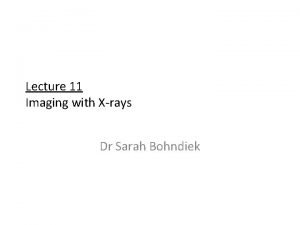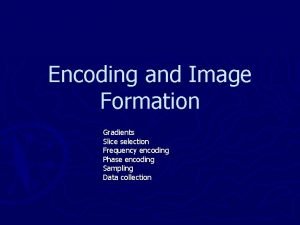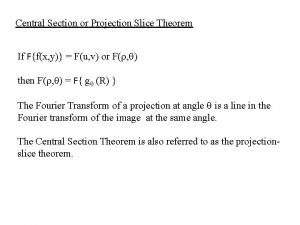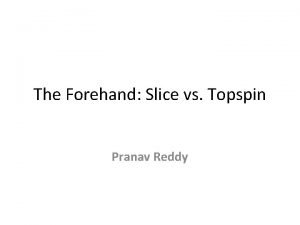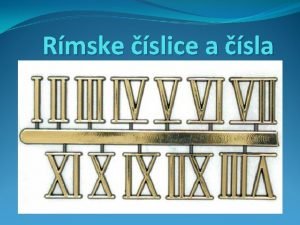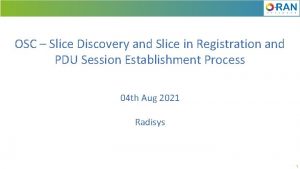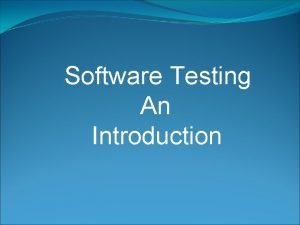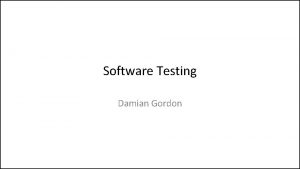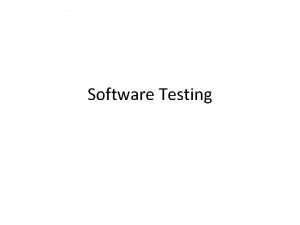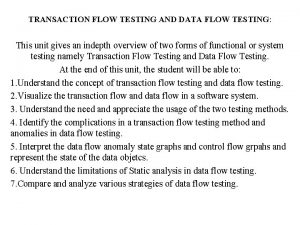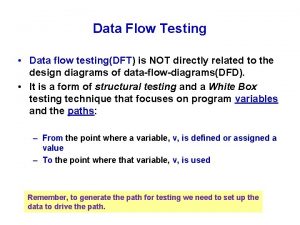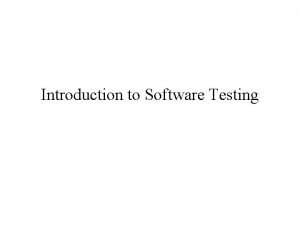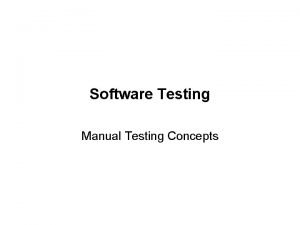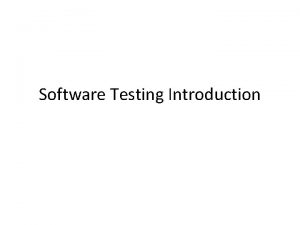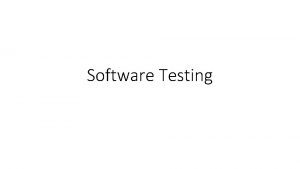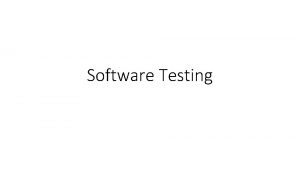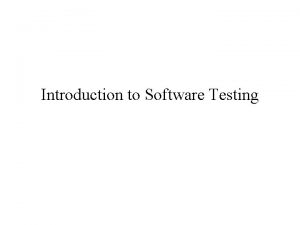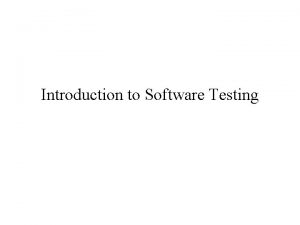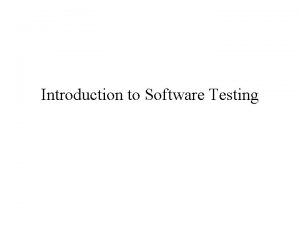Chapter 10 Data Flow Testing Slice Testing Software


























- Slides: 26

Chapter 10 Data Flow Testing Slice Testing Software Testing: A Craftsman’s Approach, 3 rd Edition Data Flow Testing

Data Flow Testing • Often confused with "dataflow diagrams“. • Main concern: places in a program where data values are defined and used. • Static (compile time) and dynamic (execution time) versions. • Static: Define/Reference Anomalies on a variable that – is defined but never used (referenced) – is used but never defined – is defined more than once • Starting point is a program, P, with program graph G(P), and the set V of variables in program P. • "Interesting" data flows are then tested as mini-functions. Software Testing: A Craftsman’s Approach, 3 rd Edition Data Flow Testing

Definitions • Node n G(P) is a defining node of the variable v V, written as DEF(v, n), iff the value of the variable v is defined at the statement fragment corresponding to node n. • Node n G(P) is a usage node of the variable v V, written as USE(v, n), iff the value of the variable v is used at the statement fragment corresponding to node n. • A usage node USE(v, n) is a predicate use (denoted as P-use) iff the statement n is a predicate statement; otherwise, USE(v, n) is a computation use (denoted C-use). Software Testing: A Craftsman’s Approach, 3 rd Edition Data Flow Testing

More Definitions • A definition-use path with respect to a variable v (denoted du-path) is a path in PATHS(P) such that for some v V, there are define and usage nodes DEF(v, m) and USE(v, n) such that m and n are the initial and final nodes of the path. • A definition-clear path with respect to a variable v (denoted dc-path) is a definition-use path in PATHS(P) with initial and final nodes DEF (v, m) and USE (v, n) such that no other node in the path is a defining node of v. Software Testing: A Craftsman’s Approach, 3 rd Edition Data Flow Testing

Example: first part of the Commission Program 1. Program Commission (INPUT, OUTPUT) 2. Dim locks, stocks, barrels As Integer 3. Dim lock. Price, stock. Price, barrel. Price As Real 4. Dim total. Locks, total. Stocks, total. Barrels As Integer 5. Dim lock. Sales, stock. Sales, barrel. Sales As Real 6. Dim sales, commission As Real 7. lock. Price = 45. 0 8. stock. Price = 30. 0 9. barrel. Price = 25. 0 10. total. Locks = 0 11. total. Stocks = 0 12. total. Barrels = 0 13. Input(locks) 14. While NOT(locks = -1) 15. Input(stocks, barrels) 16. total. Locks = total. Locks + locks 17. total. Stocks = total. Stocks + stocks 18. total. Barrels = total. Barrels + barrels 19. Input(locks) 20. End. While 21. Output(“Locks sold: “, total. Locks) 22. Output(“Stocks sold: “, total. Stocks) 23. Output(“Barrels sold: “, total. Barrels) Software Testing: A Craftsman’s Approach, 3 rd Edition Data Flow Testing

Rest of Commission Problem 23. Output(“Barrels sold: “, total. Barrels) 24. lock. Sales = lock. Price * total. Locks 25. stock. Sales = stock. Price * total. Stocks 26. barrel. Sales = barrel. Price * total. Barrels 27. sales = lock. Sales + stock. Sales + barrel. Sales 28. Output(“Total sales: “, sales) 29. If (sales > 1800. 0) 30. Then 31. commission = 0. 10 * 1000. 0 32. commission = commission + 0. 15 * 800. 0 33. commission = commission + 0. 20 *(sales-1800. 0) 34. Else If (sales > 1000. 0) 35. Then 36. commission = 0. 10 * 1000. 0 37. commission = commission + 0. 15 *(sales-1000. 0) 38. Else 39. commission = 0. 10 * sales 40. End. If 41. End. If 42. Output(“Commission is $”, commission) 43. End Commission Software Testing: A Craftsman’s Approach, 3 rd Edition Data Flow Testing

Program Graph of Commission Problem 7 8 9 10 11 12 13 15 16 17 18 19 20 22 23 24 25 26 27 42 43 14 21 28 29 30 34 31 35 32 36 33 37 38 39 40 Software Testing: A Craftsman’s Approach, 3 rd Edition 41 Data Flow Testing

Define/Use Test Cases • Technique: for a particular variable, – find all its definition and usage nodes, then – find the du-paths and dc-paths among these. – for each path, devise a "suitable" (functional? ) set of test cases. • Note: du-paths and dc-paths have both static and dynamic interpretations – Static: just as seen in the source code – Dynamic: must consider execution-time flow (particularly for loops) • Definition clear paths are easier to test – No need to check each definition node, as is necessary for du-paths Software Testing: A Craftsman’s Approach, 3 rd Edition Data Flow Testing

Define and Use Nodes Defined at Node Used at Node locks 13, 19 14, 16 stocks 15 17 barrels 15 18 total. Locks 10, 16 16, 21, 24 total. Stocks 11, 17 17, 22, 25 total. Barrels 12, 18 18, 23, 26 Variable Software Testing: A Craftsman’s Approach, 3 rd Edition Data Flow Testing

Example (continued) 13. Input(locks) 14. While NOT(locks = -1) 15. Input(stocks, barrels) 16. total. Locks = total. Locks + locks 17. total. Stocks = total. Stocks + stocks 18. total. Barrels = total. Barrels + barrels 19. Input(locks) 20. End. While We have • DEF (locks, 13), DEF (locks, 19) • USE (locks, 14), a predicate use • USE (locks, 16). A computation use • du-paths for locks are the node sequences <13, 14> (a dc-path), • • <13, 14, 15, 16>, <19, 20, 14 >, < 19, 20, 14 , 15, 16> Is <13, 14, 15, 16> definition clear? Is < 19, 20, 14, 15, 16> definition clear? What about repetitions? Software Testing: A Craftsman’s Approach, 3 rd Edition Data Flow Testing

Coverage Metrics Based on du-paths • In the following definitions, T is a set of paths in the program graph G(P) of a program P, with the set V of variables. • The set T satisfies the All-Defs criterion for the program P iff for every variable v V, T contains definition-clear paths from every defining node of v to a use of v. • The set T satisfies the All-Uses criterion for the program P iff for every variable v V, T contains definition-clear paths from every defining node of v to every use of v, and to the successor node of each USE(v, n). Software Testing: A Craftsman’s Approach, 3 rd Edition Data Flow Testing

Coverage Metrics Based on du-paths (continued) • The set T satisfies the All-P-Uses/Some C-Uses criterion for the program P iff for every variable v V, T contains definition-clear paths from every defining node of v to every predicate use of v; if a definition of v has no P-uses, a definition-clear path leads to at least one computation use. Software Testing: A Craftsman’s Approach, 3 rd Edition Data Flow Testing

Coverage Metrics Based on du-paths (continued) • The set T satisfies the All-C-Uses/Some P-Uses criterion for the program P iff for every variable v V, T contains definition-clear paths from every defining node of v to every computation use of v; if a definition of v has no C-uses, a definition-clear path leads to at least one predicate use. Software Testing: A Craftsman’s Approach, 3 rd Edition Data Flow Testing

Coverage Metrics Based on du-paths (concluded) • The set T satisfies the All-du-paths criterion for the program P iff for every variable v V, T contains definition-clear paths from every defining node of v to every use of v and to the successor node of each USE(v, n), and that these paths are either single-loop traversals or cycle-free. Software Testing: A Craftsman’s Approach, 3 rd Edition Data Flow Testing

Rapps-Weyuker Coverage Subsumption All Paths All DU Paths All Uses All P Uses Some C Uses All C Uses Some P Uses All Defs All P Uses All Edges All Nodes S. Rapps and E. J. Weyuker "Selecting Software Test Data Using Data Flow Information" IEEE Transactions of Software Engineerin, gvol 11 no 4 IEEE Computer Society Press, Washington, D. C. , April 1985, pp 367 - 375. Software Testing: A Craftsman’s Approach, 3 rd Edition Data Flow Testing

Exercise: Where does the “All definition-clear paths” coverage metric fit in the Rapps-Weyuker lattice? Software Testing: A Craftsman’s Approach, 3 rd Edition Data Flow Testing

Data Flow Testing Strategies • Data flow testing is indicated in – Computation-intensive applications – “long” programs – Programs with many variables • A definition-clear du-path represents a small function that can be tested by itself. • If a du-path is not definition-clear, it should be tested for each defining node. Software Testing: A Craftsman’s Approach, 3 rd Edition Data Flow Testing

Slice Testing • Often confused with "module execution paths" • Main concern: portions of a program that "contribute" to the value of a variable at some point in the program. • Nice analogy with history -- a way to separate a complex system into "disjoint" components that interact: – European history – North American history – Orient history • A dynamic construct. Software Testing: A Craftsman’s Approach, 3 rd Edition Data Flow Testing

Slice Testing Definitions Starting point is a program, P, with program graph G(P), and the set V of variables in program P. Nodes in the program graph are numbered and correspond to statement fragments. • Definition: The slice on the variable set V at statement fragment n, written S(V, n), is the set of node numbers of all statement fragments in P prior to n that contribute to the values of variables in V at statement fragment n. • This is actually a “backward slice”. • Exercise: define a “forward slice”. Software Testing: A Craftsman’s Approach, 3 rd Edition Data Flow Testing

Fine Points • "prior to" is the dynamic part of the definition. • "contribute" is best understood by extending the Define and Use concepts: – – – – P-use: used in a predicate (decision) C-use: used in computation O-use: used for output L-use: used for location (pointers, subscripts) I-use: iteration (internal counters, loop indices) I-def: defined by input A-def: defined by assignment • usually, the set V of variables consists of just one element. • can choose to define a slice as a compilable set of statement fragments -- this extends the meaning of "contribute" • because slices are sets, we can develop a lattice based on the subset relationship. Software Testing: A Craftsman’s Approach, 3 rd Edition Data Flow Testing

In the program fragment 13. Input(locks) 14. While NOT(locks = -1) 15. Input(stocks, barrels) 16. total. Locks = total. Locks + locks 17. total. Stocks = total. Stocks + stocks 18. total. Barrels = total. Barrels + barrels 19. Input(locks) 20. End. While There are these slices on locks (notice that statements 15, 17, and 18 do not appear): S 1: S(locks, 13) = {13} S 2: S(locks, 14) = {13, 14, 19, 20} S 3: S(locks, 16) = {13, 14, 19, 20} S 4: S(locks, 19) = {19} Software Testing: A Craftsman’s Approach, 3 rd Edition Data Flow Testing

Lattice of Slices • Because a slice is a set of statement fragment numbers, we can find slices that are subsets of other slices. • This allows us to “work backwards” from points in a program, presumably where a fault is suspected. • The statements leading to the value of commission when it is output are an excellent example of this pattern. • Some researchers propose that this is the way good programmers think when they debug code. Software Testing: A Craftsman’s Approach, 3 rd Edition Data Flow Testing

Example Lattice of Slices S 34 S 35 S 37 S 36 S 38 S 34: S(commission, 41) = {41} S 39 S 40 S 35: S(commission, 42) = {41, 42} S 36: S(commission, 43) = {3, 4, 5, 19, 20, 21, 22, 23, 24, 25, 26, 27, 28, 30, 36, 41, 42, 43} S 37: S(commission, 47) = {47} S 38: S(commission, 48) = {3, 4, 5, 19, 20, 21, 22, 23, 24, 25, 26, 27, 28, 29, 30, 36, 47, 48} S 39: S(commission, 50) = {3, 4, 5, 19, 20, 21, 22, 23, 24, 25, 26, 27, 28, 29, 30, 36, 50} S 40: S(commission, 51) = {3, 4, 5, 19, 20, 21, 22, 23, 24, 25, 26, 27, 28, 29, 30, 36, 41, 42, 43, 47, 48, 50} Software Testing: A Craftsman’s Approach, 3 rd Edition Data Flow Testing

Diagnostic Testing with Slices • Relative complements of slices yield a "diagnostic" capability. The relative complement of a set B with respect to another set A is the set of all elements of A that are not elements of B. It is denoted as A - B. • Consider the relative complement set S(commission, 48) S(sales, 35): – S(commission, 48) = {3, 4, 5, 36, 18, 19, 20, 23, 24, 25, 26, 27, 34, 38, 39, 40, 44, 45, 47} – S(sales, 35) = {3, 4, 5, 36, 18, 19, 20, 23, 24, 25, 26, 27} – S(commission, 48) - S(sales, 35) = {34, 38, 39, 40, 44, 45, 47} • If there is a problem with commission at line 48, we can divide the program into two parts, the computation of sales at line 34, and the computation of commission between lines 35 and 48. If sales is OK at line 34, the problem must lie in the relative complement; if not, the problem may be in either portion. Software Testing: A Craftsman’s Approach, 3 rd Edition Data Flow Testing

Programming with Slices • One researcher suggests the possibility of “slice splicing”: – Code a slice, compile and test it. – Code another slide, compile and test it, then splice the two slices. – Continue until the whole program is complete. • Exercise: in what ways is slice splicing distinct from agile (bottom up) programming? Software Testing: A Craftsman’s Approach, 3 rd Edition Data Flow Testing

Exercise/Discussion: When should testing stop? • when you run out of time? • when continued testing causes no new failures? • when continued testing reveals no new faults? • when you can't think of any new test cases? • when you reach a point of diminishing returns? • when mandated coverage has been attained? • when all faults have been removed? Software Testing: A Craftsman’s Approach, 3 rd Edition Data Flow Testing
 Data flow testing strategies in software testing
Data flow testing strategies in software testing Transform flow and transaction flow
Transform flow and transaction flow Domain testing in software testing methodologies
Domain testing in software testing methodologies Motivational overview in software testing
Motivational overview in software testing Globalization testing in software testing
Globalization testing in software testing Decision table testing in software testing
Decision table testing in software testing Control structure testing in software engineering
Control structure testing in software engineering Decision table testing in software testing
Decision table testing in software testing Decision table technique
Decision table technique Extended entry decision table
Extended entry decision table Rigorous testing in software testing
Rigorous testing in software testing Testing blindness in software testing
Testing blindness in software testing Domain testing example
Domain testing example Data flow vs control flow
Data flow vs control flow Control flow and data flow computers
Control flow and data flow computers Data flow anomaly state graph
Data flow anomaly state graph What is data flow testing
What is data flow testing Data flow and mutation testing
Data flow and mutation testing Data flow testing
Data flow testing Cspec in software engineering
Cspec in software engineering Data flow model in software engineering
Data flow model in software engineering Every pale tomato slice wilted pickle
Every pale tomato slice wilted pickle Slice selection
Slice selection Central slice theorem
Central slice theorem Slice selection gradient
Slice selection gradient Central section theorem
Central section theorem Forehand slice
Forehand slice















